Interannual Variations in Headland-Bay Beach Profiles and Sediment Under Artificial Island Influence: A Case Study of Puqian Bay, Hainan Island, China
Abstract
1. Introduction
2. Materials and Methods
2.1. Research Area
2.2. Methods
2.2.1. Sampling and Data Collection
2.2.2. Empirical Orthogonal Function (EOF) Analysis
3. Results
3.1. Beach Profile Changes
3.2. Interannual Grain Size Variations
4. Discussion
4.1. Spatial Differences in Headland-Bay Beach Evolution
4.1.1. Guilinyang Beach Profile Evolution: Natural Wave-Dominated, Sheltered Headland Bay Section
4.1.2. Hilton Beach Profile Evolution: Erosional Open Headland Bay Section Under Artificial Island Influence
4.2. Influence of the Artificial Island
4.3. Differences in Sediment Grain Size Characteristics
4.4. Limitations and Implications of the Study
5. Conclusions
- Beach profiles and sediment grain-size variations in Puqian Bay are governed by seasonal waves. Guilinyang Beach exhibits a seasonal accretion–erosion cycle with seaward sandbar migration, whereas Hilton Beach shows long-term erosion linked to changes in wave direction and artificial structures, reflecting spatial hydrodynamic differences and local geomorphologic control.
- The construction of the artificial island altered wave propagation directions and energy distribution, reshaping sedimentary patterns in Puqian Bay. This has led to persistent erosion and sediment coarsening at Hilton Beach, demonstrating the “quasi-headland” effect of the artificial island, which has become a major factor governing beach profile evolution and sediment transport in the region.
Author Contributions
Funding
Data Availability Statement
Conflicts of Interest
References
- Kulkarni, S.J.; Deshbhandari, P.G.; Jayappa, K.S. Seasonal variation in textural characteristics and sedimentary environments of beach sediments, Karnataka coast, India. Aquat. Procedia 2015, 4, 117–124. [Google Scholar] [CrossRef]
- Vila-Concejo, A.; Fellowes, T.E.; Gallop, S.; Alejo, I.; Angnuureng, D.B.; Benavente, J.; Bosma, J.W.; Brempong, E.K.; Dissanayake, P.; Gazi, Y.; et al. Morphodynamics and management challenges for beaches in modified estuaries and bays. Camb. Prism. Coast. Futures 2024, 2, e11. [Google Scholar] [CrossRef]
- Barbier, E.B.; Hacker, S.D.; Kennedy, C.; Koch, E.W.; Stier, A.C.; Silliman, B.R. The value of estuarine and coastal ecosystem services. Ecol. Monogr. 2011, 81, 169–193. [Google Scholar] [CrossRef]
- Di Paola, G.; Rodríguez, G.; Rosskopf, C.M. Shoreline Dynamics and Beach Erosion. Geosciences 2023, 13, 74. [Google Scholar] [CrossRef]
- Masselink, G.; Short, A.D. The effect of tide range on beach morphodynamics and morphology: A conceptual beach model. J. Coast. Res. 1993, 9, 785–800. [Google Scholar]
- Nnafie, A.; de Swart, H.E.; Falqués, A.; Calvete, D. Long-term morphodynamics of a coupled shelf-shoreline system forced by waves and tides: A model approach. J. Geophys. Res. Earth Surf. 2021, 126, e2021JF006315. [Google Scholar] [CrossRef]
- Rodriguez-Padilla, I.; Marino-Tapia, I.; De Alegria-Arzaburu, A.R. Daily timescale analysis of sediment transport and topographic changes on a mesotidal sandy beach under low to moderate wave conditions. Mar. Geol. 2024, 474, 107323. [Google Scholar] [CrossRef]
- Xu, W.; Chen, S.; Ji, H.; Hu, T.; Zhong, X.; Li, P. Dynamics of sandy shorelines and their response to wave climate change in the east of Hainan Island, China. J. Mar. Sci. Eng. 2024, 12, 1921. [Google Scholar] [CrossRef]
- Lazarus, E.D.; Harley, M.D.; Blenkinsopp, C.E.; Turner, I.L. Environmental signal shredding on sandy coastlines. Earth Surf. Dyn. 2019, 7, 77–86. [Google Scholar] [CrossRef]
- D’Alessandro, F.; Tomasicchio, G.R.; Frega, F.; Leone, E.; Francone, A.; Pantusa, D.; Foti, G. Beach–dune system morphodynamics. J. Mar. Sci. Eng. 2022, 10, 627. [Google Scholar] [CrossRef]
- Casamayor, M.; Alonso, I.; Valiente, N.G.; Sánchez-García, M.J. Seasonal response of a composite beach in relation to wave climate. Geomorphology 2022, 408, 108245. [Google Scholar] [CrossRef]
- Pradhan, U.; Mishra, P.; Mohanty, P.K. Beach and nearshore sediment textural characteristics of a monsoonal wave-dominated micro-tidal, human perturbed environment, Central East Coast of India. Arab. J. Geosci. 2022, 15, 667. [Google Scholar] [CrossRef]
- McFall Brian, C. The relationship between beach grain size and intertidal beach face slope. J. Coast. Res. 2019, 35, 1080. [Google Scholar] [CrossRef]
- Dean, R.G. Equilibrium beach profiles: Characteristics and applications. J. Coast. Res. 1991, 7, 53–84. [Google Scholar]
- Li, Y.; Yao, H.; Chen, Z.; Luo, W.; Zhang, S. Morphology and evolution of submarine sand ridges and sand waves off the southwestern coast of Hainan Island, China. Front. Mar. Sci. 2025, 12, 1561392. [Google Scholar] [CrossRef]
- Darsan, J. Beach morphological dynamics at Cocos Bay (Manzanilla), Trinidad. Atl. Geosci. 2013, 49, 151–168. [Google Scholar] [CrossRef]
- Qu, K.; Chen, K.; Wang, N.; Zheng, J.; Lu, P. Geomorphological processes following the construction of an offshore artificial island in the radial sand ridges of the South Yellow Sea. Coast. Eng. 2024, 192, 104545. [Google Scholar] [CrossRef]
- Chen, L.; Zhou, Z.; Xu, M.; Xu, F.; Tao, J.; Zhang, C. Exploring the influence of land reclamation on sediment grain size distribution on tidal flats: A numerical study. Coast. Eng. Proc. 2018, 1, 85. [Google Scholar] [CrossRef]
- Flemming, B.W.; Nyandwi, N. Land reclamation as a cause of fine-grained sediment depletion in backbarrier tidal flats (Southern North Sea). Neth. J. Aquat. Ecol. 1994, 28, 299–307. [Google Scholar] [CrossRef]
- Li, S.; Lv, B.; Yang, Y.; Yang, Y.; Wang, C. Effects of Offshore Artificial Islands on Beach Stability of Sandy Shores: Case Study of Hongtang Bay, Hainan Province. Front. Earth Sci. 2022, 16, 876–889. [Google Scholar] [CrossRef]
- Zhu, G.; Ren, B.; Wen, H.; Lin, P. Numerical simulation on the influence of artificial island on reef hydrodynamics. Appl. Ocean. Res. 2024, 153, 104266. [Google Scholar] [CrossRef]
- Lim, C.; Lim, T.M.; Lee, J.-L. Severe beach erosion induced by shoreline deformation after a large-scale reclamation project for the Samcheok liquefied natural gas (LNG) terminal in South Korea. Nat. Hazards Earth Syst. Sci. 2025, 25, 3239–3255. [Google Scholar] [CrossRef]
- Van Ginkel, M.; Olsthoorn, T.N. Distribution of grain size and resulting hydraulic conductivity in land reclamations constructed by bottom dumping, rainbowing and pipeline discharge. Water Resour. Manag. 2019, 33, 993–1012. [Google Scholar] [CrossRef]
- Ranasinghe, R.; Turner, I.L. Shoreline response to submerged structures: A review. Coast. Eng. 2006, 53, 65–79. [Google Scholar] [CrossRef]
- Kraus, N.C.; McDougal, W.G. The effects of seawalls on the beach: Part I, an updated literature review. J. Coast. Res. 1996, 12, 691–701. [Google Scholar]
- Harley, M.D.; Turner, I.L.; Short, A.D.; Ranasinghe, R. A reevaluation of coastal embayment rotation: The dominance of cross-shore versus alongshore sediment transport processes, Collaroy-Narrabeen Beach, southeast Australia. J. Geophys. Res. Earth Surf. 2011, 116, F04033. [Google Scholar] [CrossRef]
- Bracs, M.A.; Turner, I.L.; Splinter, K.; Short, A.D.; Mortlock, T.R. Synchronised patterns of erosion and deposition observed at two beaches. Mar. Geol. 2016, 380, 196–204. [Google Scholar] [CrossRef]
- Yuan, R.; Xu, R.; Zhang, H.; Hua, Y.; Zhang, H.; Zhong, X.; Chen, S. Detecting shoreline changes on the beaches of Hainan Island (China) for the period 2013–2023 using multi-source data. Water 2024, 16, 1034. [Google Scholar] [CrossRef]
- Hu, R.; Fan, Y.; Zhang, X. Satellite-derived shoreline changes of an urban beach and their relationship to coastal engineering. Remote Sens. 2024, 16, 2469. [Google Scholar] [CrossRef]
- Zhu, Y.; Zhou, Y.; Zeng, W.; Feng, W.; Jiang, Y. The feedback from a beach berm during post-storm recovery and how to improve the berms restorative efficiency. Water 2024, 16, 1955. [Google Scholar] [CrossRef]
- Tan, Z.; Lin, C.; He, S.; Lou, Q. Analysis of erosion and deposition evolution of the beach of Puqian Bay in Haikou. J. Mar. Sci. Technol. 2023, 42, 78–86. (In Chinese) [Google Scholar] [CrossRef]
- Wu, D.; Zhang, H.; Zhang, D.; Fu, G. Annual changes characteristics of beach topography in the northeastern bays of Hainan Province. Coast. Eng. 2021, 40, 29–36. (In Chinese) [Google Scholar] [CrossRef]
- Zhu, Y.; Zeng, W.; Zhou, Y.; Zhang, J. Shoreline behavior in response to coastal structures: A case study in Haikou Bay, China. Water 2024, 16, 3106. [Google Scholar] [CrossRef]
- U.S. Environmental Protection Agency. Methods for Collection, Storage and Manipulation of Sediment Samples for Laboratory Analysis; U.S. EPA: Washington, DC, USA, 2001. [Google Scholar]
- Folk, R.L. The distinction between grain size and mineral composition in sedimentary-rock nomenclature. J. Geol. 1954, 62, 344–359. [Google Scholar] [CrossRef]
- Miller, J.K.; Dean, R.G. Shoreline variability via empirical orthogonal function analysis: Part II relationship to nearshore conditions. Coast. Eng. 2007, 54, 133–150. [Google Scholar] [CrossRef]
- Hu, T.; Li, Z.; Zeng, C.; Li, G.; Zhang, H. Applications of EMD to analyses of high-frequency beachface responses to Storm Bebinca in the Qing’an Bay, Guangdong Province, China. Acta Oceanol. Sin. 2022, 41, 147–162. [Google Scholar] [CrossRef]
- Chen, W.; van der Werf, J.J.; Hulscher, S.J.M.H. A review of practical models of sand transport in the swash zone. Earth-Sci. Rev. 2023, 238, 104355. [Google Scholar] [CrossRef]
- Cao, L.; Xu, W.; Wang, P.; Shi, P.; Feng, W. Response of hydrodynamic and erosion–deposition pattern to artificial island construction in Puqian Bay. Mar. Lake Bull. 2013, 3, 161–171. (In Chinese) [Google Scholar] [CrossRef]
- Davidson-Arnott, R.; Bauer, B.; Houser, C. Introduction to Coastal Processes and Geomorphology; Cambridge University Press: Cambridge, UK, 2019. [Google Scholar]
- Anthony, E.J. Beach erosion. In Encyclopedia of Coastal Science; Springer: Cham, Switzerland, 2019; pp. 234–246. [Google Scholar]
- Zhang, L.; Qian, D. Impact of artificial island construction on the shoreline of Puqian Bay. China Water Transp. 2017, 17, 234–237. (In Chinese) [Google Scholar]
- Kuriyama, Y. Medium-term bar behavior and associated sediment transport at Hasaki, Japan. J. Geophys. Res. Ocean. 2002, 107, 15-1–15-12. [Google Scholar] [CrossRef]
- Ge, L.; Xu, Y.; Kang, G.; Chen, S. Experimental Study on Beach Restoration under the Influence of Artificial Islands. Water 2025, 17, 972. [Google Scholar] [CrossRef]
- Liu, G.; Qi, H.; Cai, F.; Zhu, J.; Zhao, S.; Liu, J.; Lei, G.; Cao, C.; He, Y.; Xiao, Z. Initial Morphological Responses of Coastal Beaches to a Mega Offshore Artificial Island. Earth Surf. Process. Landf. 2022, 47, 1355–1370. [Google Scholar] [CrossRef]
- Pan, Y.; Kuang, C.; Chen, Y.; Yin, S.; Yang, Y.; Zhang, J.; Qiu, R.; Zhang, Y. A Comparison of the Performance of Submerged and Detached Artificial Headlands in a Beach Nourishment Project. Ocean. Eng. 2018, 159, 295–304. [Google Scholar] [CrossRef]
- Fu, G.; Li, J.; Yuan, K.; Song, Y.; Fu, M.; Wang, H.; Wan, X. Wind-Wave-Current Coupled Modeling of the Effect of Artificial Island on the Coastal Environment. Appl. Sci. 2023, 13, 7171. [Google Scholar] [CrossRef]
- Huisman, B.J.A.; De Schipper, M.A.; Ruessink, G.B. Sediment Sorting at the Sand Motor at Storm and Annual Time Scales. Mar. Geol. 2016, 381, 209–226. [Google Scholar] [CrossRef]
- Guillén, J.; Hoekstra, P. The “Equilibrium” Distribution of Grain Size Fractions and Its Implications for Cross-Shore Sediment Transport: A Conceptual Model. Mar. Geol. 1996, 135, 15–33. [Google Scholar] [CrossRef]
- Lamy, A.; Robin, N.; Smyth, T.A.G.; Hesp, P.A.; René, C.; Feyssat, P.; Raynal, O.; Hebert, B. Impact of Temporal Beach Grain Size Variability on Aeolian Sediment Transport and Topographic Evolution in a Microtidal Environment. Geomorphology 2024, 453, 109126. [Google Scholar] [CrossRef]
- Wishaw, D.; Leon, J.X.; Barnes, M.; Fairweather, H. Tropical Cyclone Impacts on Headland Protected Bay. Geosciences 2020, 10, 190. [Google Scholar] [CrossRef]
- Wright, L.D.; Short, A.D. Morphodynamic Variability of Surf Zones and Beaches: A Synthesis. Mar. Geol. 1984, 56, 93–118. [Google Scholar] [CrossRef]
- Saengsupavanich, C.; Ariffin, E.H.; Yun, L.S.; Pereira, D.A. Environmental Impact of Submerged and Emerged Breakwaters. Heliyon 2022, 8, e12626. [Google Scholar] [CrossRef]
- Chen, L.; Lin, G.; Gong, W. The impact of artificial island construction on the headland vortex and bed level change in headland–bay coastal systems: A case study in Puqian Bay, Hainan Island. J. Coast. Res. 2023, 39, 1123–1138. (In Chinese) [Google Scholar]
- Kuhnle, R.A.; Jia, Y.; Alonso, C.V. Measured and Simulated Flow Near a Submerged Spur Dike. J. Hydraul. Eng. 2008, 134, 916–924. [Google Scholar] [CrossRef]
- Harley, M.D.; Turner, I.L.; Short, A.D. New Insights into Embayed Beach Rotation: The Importance of Wave Exposure and Cross-Shore Processes. J. Geophys. Res. Earth Surf. 2015, 120, 1470–1484. [Google Scholar] [CrossRef]
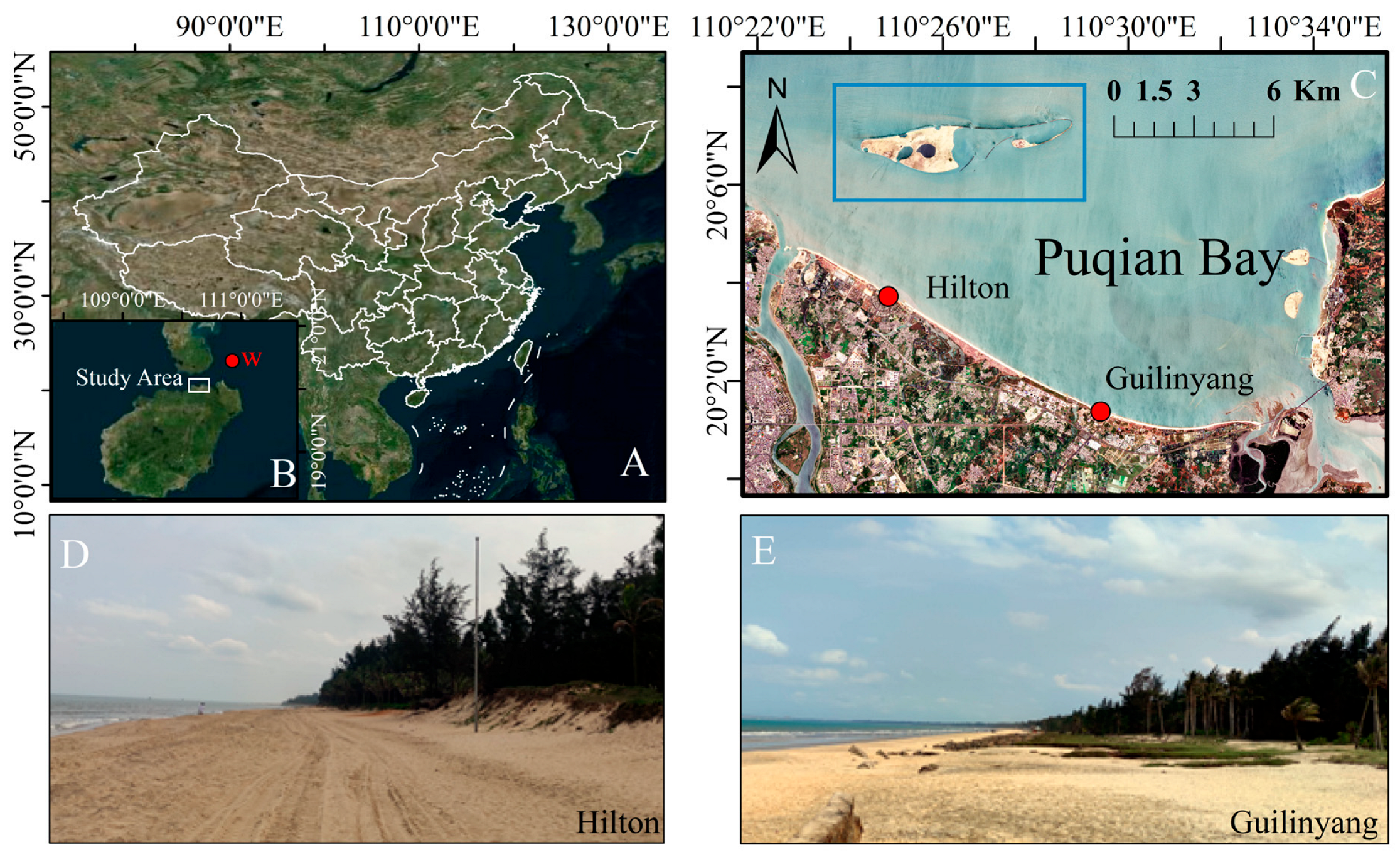
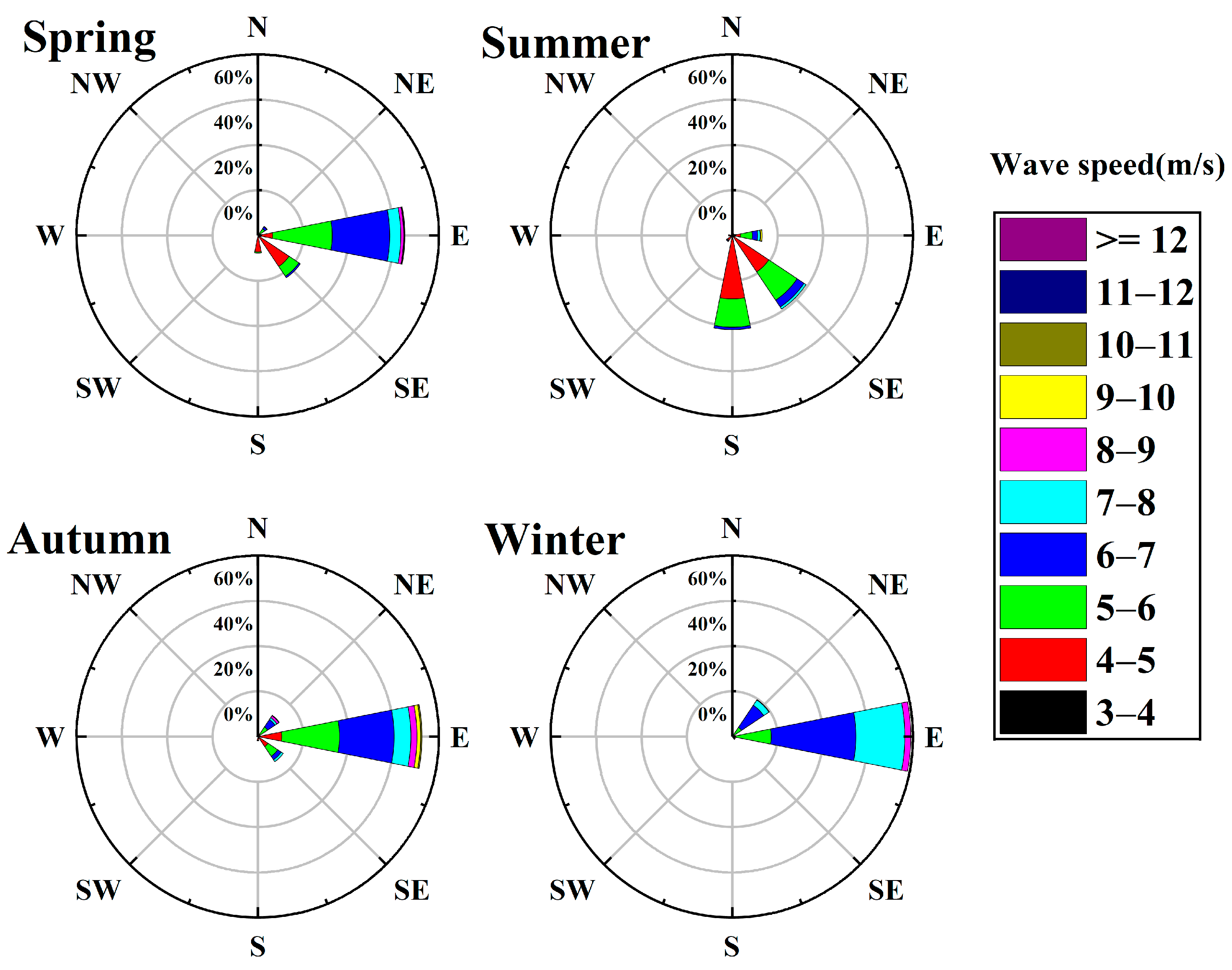
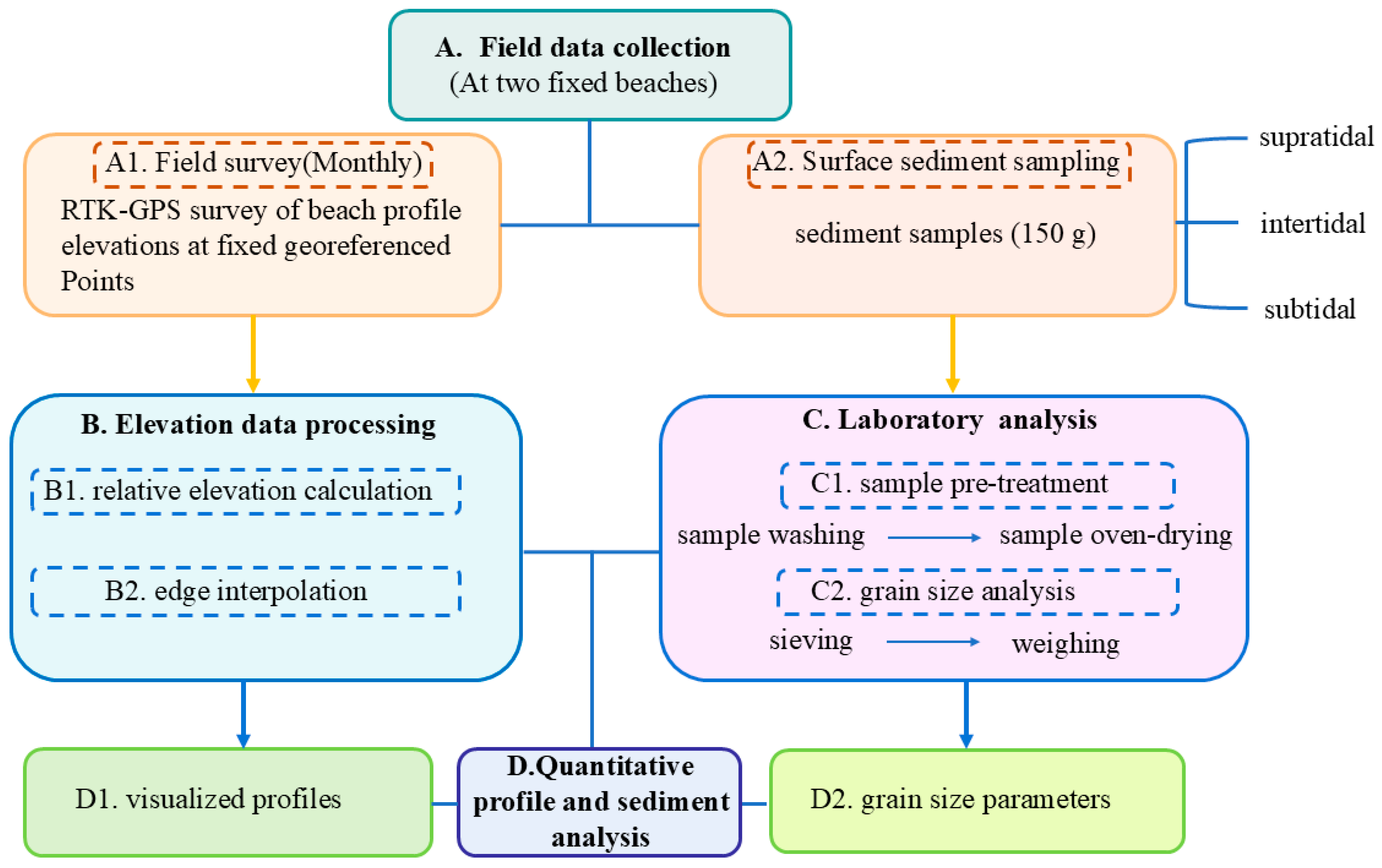
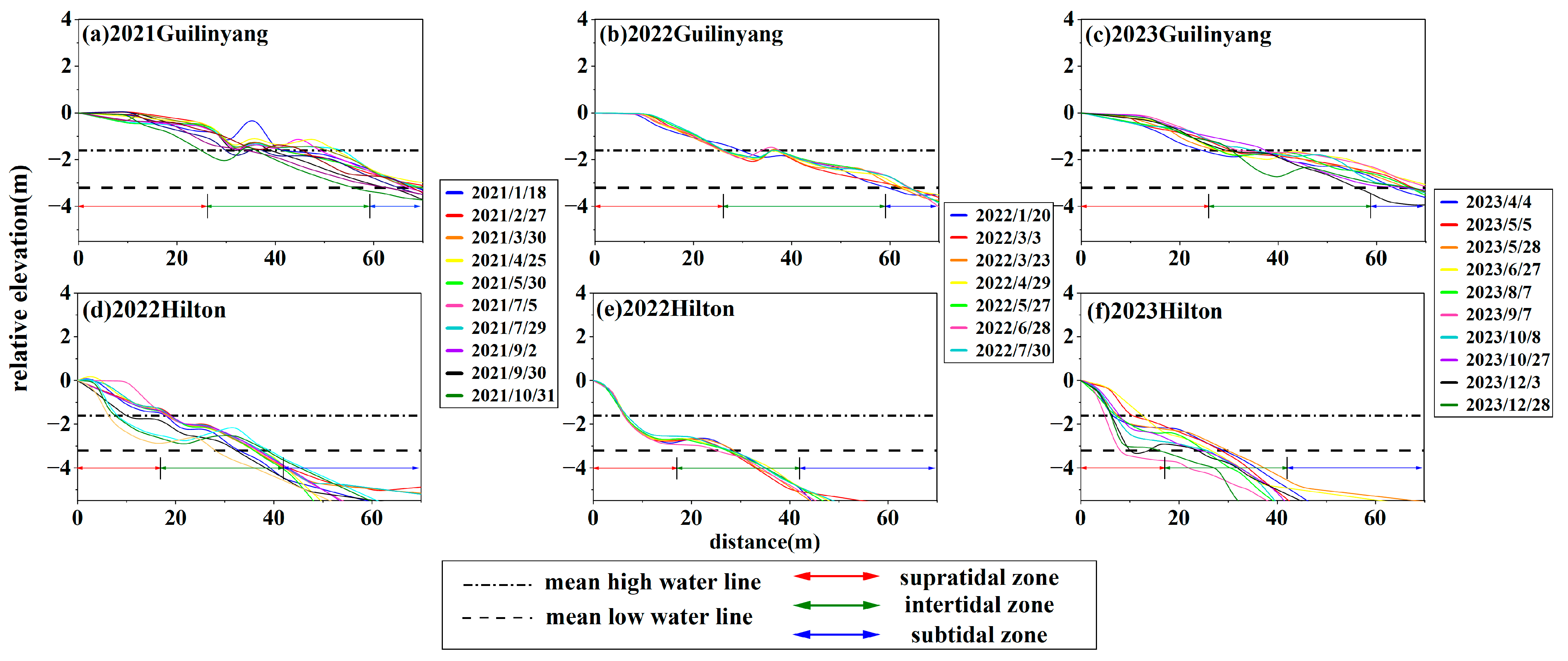
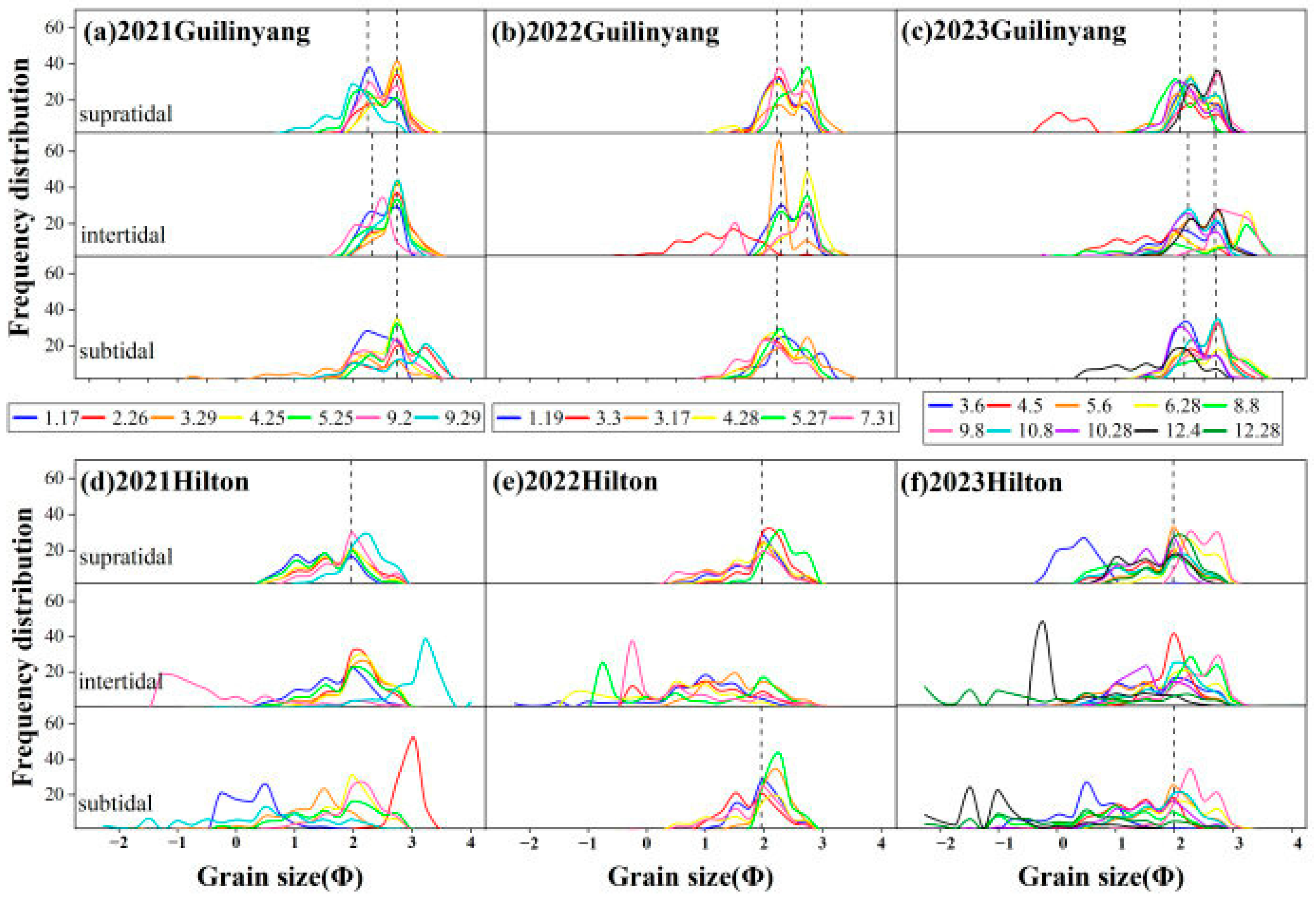
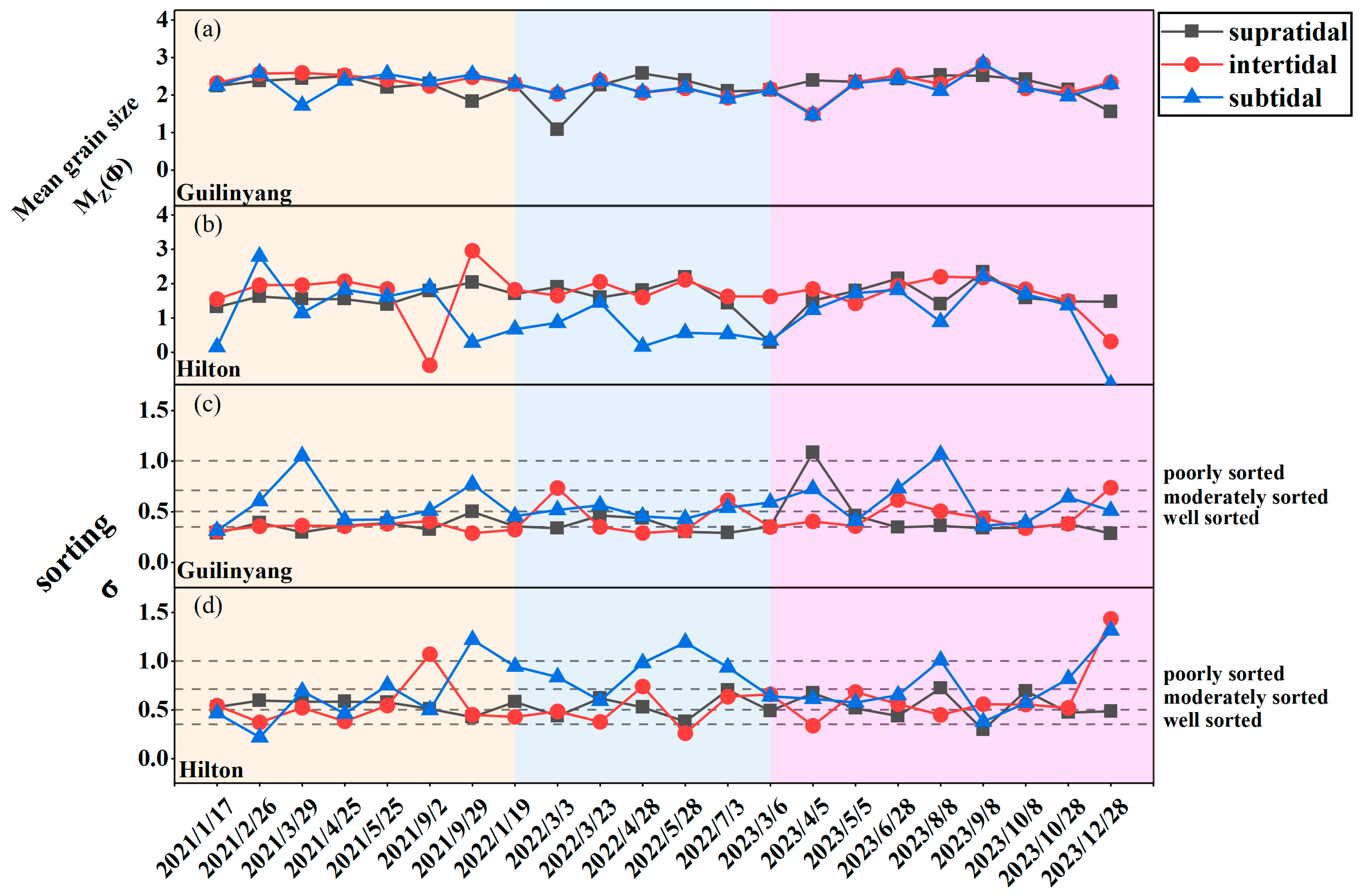
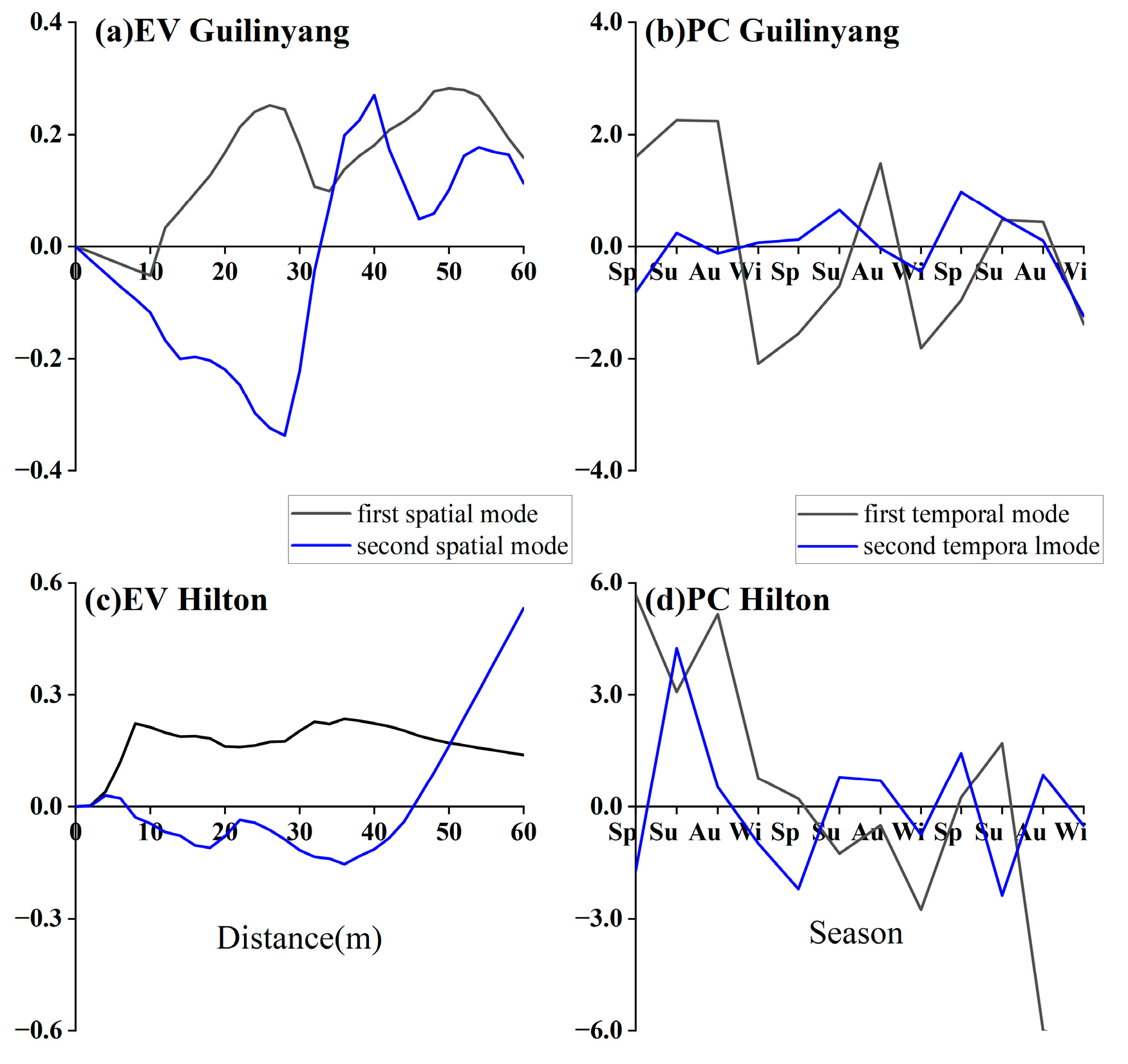
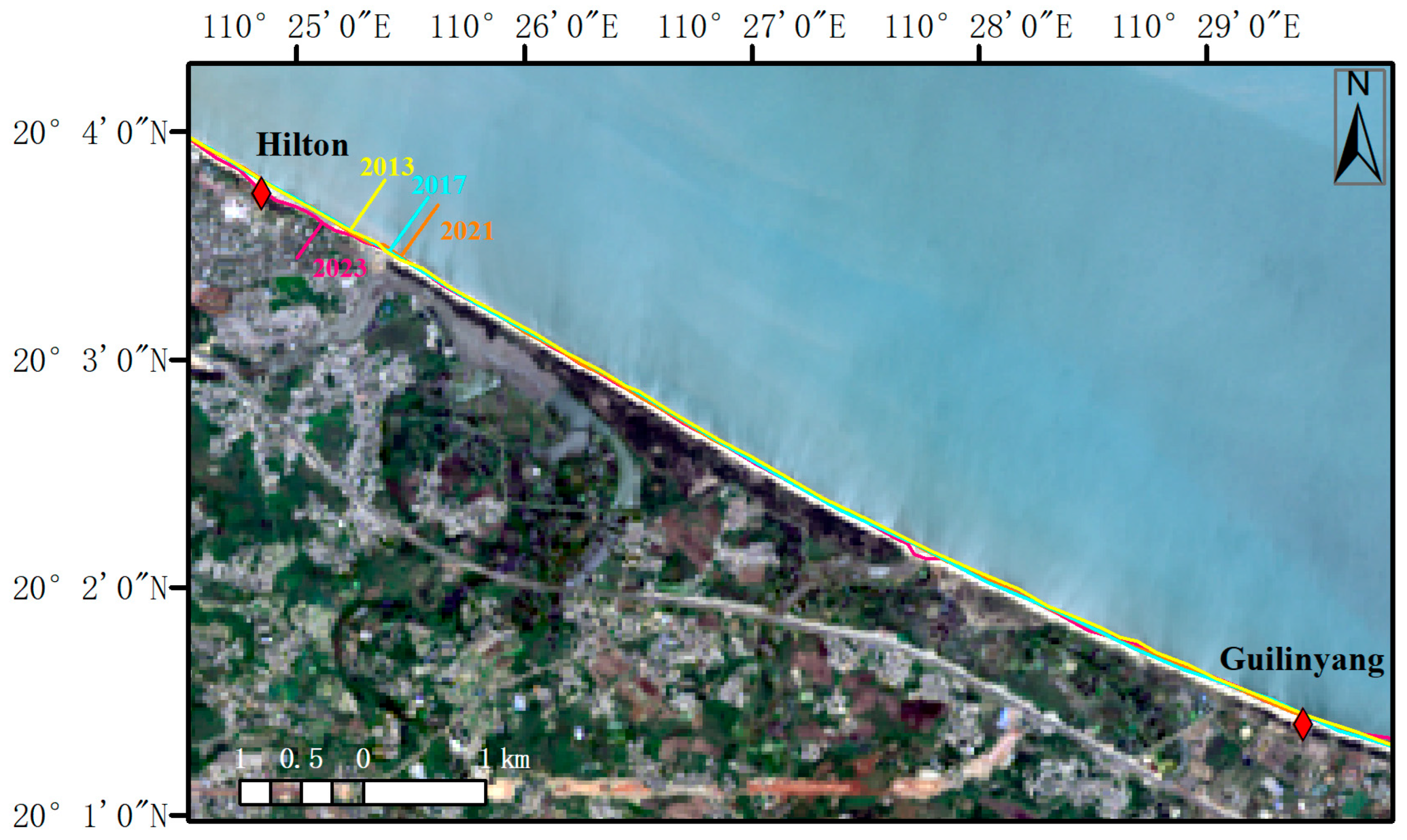

Disclaimer/Publisher’s Note: The statements, opinions and data contained in all publications are solely those of the individual author(s) and contributor(s) and not of MDPI and/or the editor(s). MDPI and/or the editor(s) disclaim responsibility for any injury to people or property resulting from any ideas, methods, instructions or products referred to in the content. |
© 2025 by the authors. Licensee MDPI, Basel, Switzerland. This article is an open access article distributed under the terms and conditions of the Creative Commons Attribution (CC BY) license (https://creativecommons.org/licenses/by/4.0/).
Share and Cite
Wang, X.; Li, Z.; Sun, Y.; Bian, X.; Zhu, D. Interannual Variations in Headland-Bay Beach Profiles and Sediment Under Artificial Island Influence: A Case Study of Puqian Bay, Hainan Island, China. J. Mar. Sci. Eng. 2025, 13, 1930. https://doi.org/10.3390/jmse13101930
Wang X, Li Z, Sun Y, Bian X, Zhu D. Interannual Variations in Headland-Bay Beach Profiles and Sediment Under Artificial Island Influence: A Case Study of Puqian Bay, Hainan Island, China. Journal of Marine Science and Engineering. 2025; 13(10):1930. https://doi.org/10.3390/jmse13101930
Chicago/Turabian StyleWang, Xuan, Zhiqiang Li, Yan Sun, Xiaodong Bian, and Daoheng Zhu. 2025. "Interannual Variations in Headland-Bay Beach Profiles and Sediment Under Artificial Island Influence: A Case Study of Puqian Bay, Hainan Island, China" Journal of Marine Science and Engineering 13, no. 10: 1930. https://doi.org/10.3390/jmse13101930
APA StyleWang, X., Li, Z., Sun, Y., Bian, X., & Zhu, D. (2025). Interannual Variations in Headland-Bay Beach Profiles and Sediment Under Artificial Island Influence: A Case Study of Puqian Bay, Hainan Island, China. Journal of Marine Science and Engineering, 13(10), 1930. https://doi.org/10.3390/jmse13101930





